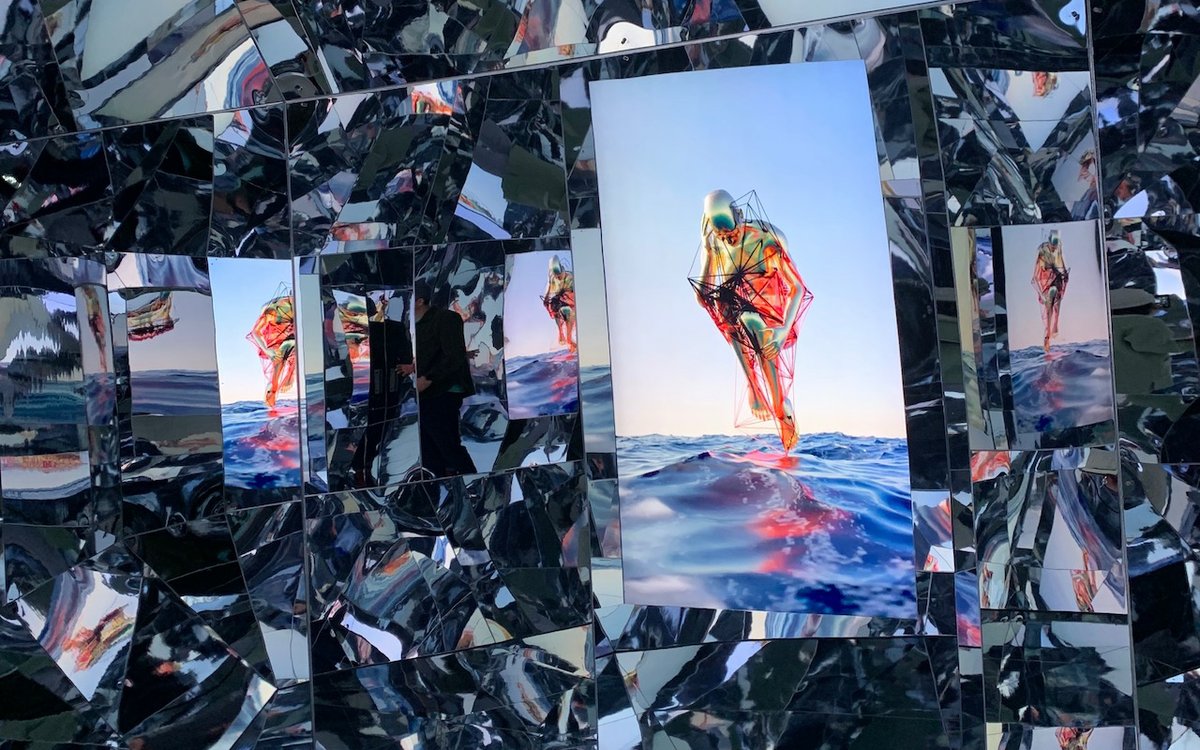At Quantum Mirror in St. Louis Park, Adrian Stein takes the conventions of artful experiences, like Immersive Van Gogh, and puts a futuristic twist on them.
by Nina Raemont – December 14, 2021 – 5:47 AM
Critics have often flouted immersive art exhibitions as fodder for Insta-hungry exhibition-goers, a great place to snap a pic and flee—a social media hit and run—all while burning a fifty-something-dollar-sized hole in your wallet. Another immersive exhibition? I thought to myself as I received the email from Quantum Mirror advertising an immersive art experience akin to the contentious Vincent Van Gogh experience.
So when I stepped foot in Adrian Stein’s Quantum Mirror hosted at St. Louis Park’s Rem5 VR Lab to find an exhibition that reclaims the notion of how and what an immersive exhibition can be, the last thing on my mind was Vincent Van Gogh.
Through looped NFTs on gallery screens, chrome mannequins with data aggregating screens as heads, and of course, the room of mirrors, Quantum Mirror urges reflection on the intersections of art and technology, and how our identities play into it all. And yes, it serves as a great photo opp as well.
The experience opened in mid-November at the VR lab, a new age entertainment center that compares their process to a bowling alley (in the sense that you can rent a pod for yourself and your friends, except the pod is rigged with a VR headset and a game list instead of a bowling lane and some uncomfortable bowling shoes). Tickets for Quantum Mirror are available through January 29 and start at $25 per person.
Quantum Mirror debuted in Chicago earlier this year, and after visiting, Brian Skalak, Rem5’s marketing director, and Amir Berenjian, Rem5’s co-founder, had entertained its viability in Minneapolis. Soon enough, the sculpture installation had begun and Rem5 ushered the exhibition into a large corner of their virtual reality lab.
Before entering the exhibition, patrons remove their shoes (so as not to dent or damage the mirror room) and then walk into a futuristic Quantum Gallery. There you’ll find a Matrix-esque waiting space surrounded by screens of all sorts. There are screens on the bodies of chromium mannequins, aggregating content that mentions the words “artificial intelligence,” “virtual reality,” “technology,”and “metaverse” on the web; there’s a gallery screen displaying Stein’s Continuity, a looping NFT of an Androgenie cache (Stein’s artistic representation of human consciousness) floating in the abyss; there’s a screen for sending a message to your digital self, if you’re into that. Right before the Quantum Concierge releases the Metaverse cracken and opens the gates to the mirror room, a VR headset is placed upon your head. And things get weirder.
“Welcome to the Consciousness Upload Station,” a voice says as you stare into the ether. Then, the voice instructed me to hold out my hands, so as to catch a glimpse of “your digital twin.” A set of silver hands appeared before me. Suddenly, I was staring into the digital version of yourself—”your consciousness enlightened and extrapolated by digital technology.”
Through the VR theatrics, you reach out to touch the Androgenies, exercising “perceived control” of yourself and your identity replications. How many digital identities have you curated of yourself? Are they representative of who you are, or who you want to be?
After the meta mindfuck comes to an end, you return the headset and await the doors of the mirror room to open. Once they do, your own reflection greets you, replicated ad infinitum in a sea of mirrors alongside fluorescent color schemes and moving images on the center screens. Slowed down Gregorian chants—one singing Glory of God, the other singing Fear of God—fill your earlobes.
As I meandered through the hexagonal hall of mirrors, I pulled out my phone to take a picture. How peculiar it is, I thought to myself, that Stein created one of the most Instagrammable art exhibitions to serve as a critique of our digital identities. I felt the contradictions creeping up on me as I captured an image of myself in the space.
Just last month, Mark Zuckerberg announced Facebook’s push for the metaverse, a place Zuckerberg calls the future and successor of the internet, where we interact with one another through Oculus headsets and imaginary spaces.
Quantum Mirror is art for the metaverse. It takes an immersive art experience like Immersive Van Gogh and amps it up with kilowatts of crypto and thoughtful discourse on the future of the art world and our online identities. For thirty minutes in the mirror room, patrons can revel in these intricacies of identity and performance in these imaginary yet deeply real spaces, or they can take a picture of themselves and leave.

